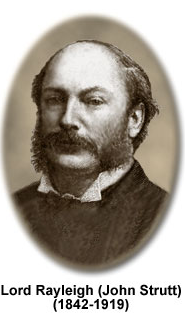Light Scattering
Claimed by Zhaoxian Zhang (Summer 2022)
Light scattering is the change in momentum and energy of light when it passes through an object. Light scattering occurs because light, as a form of Electromagnetic Radiation, interacts with charge. This often happens with light interacting with Electric Dipole. dusts in the air, molecules in the air, particles in solutions, water droplets, and many other common things can form dipoles. These interactions lead to everyday phenomena like whiteness of cloud or the redness of sunset, and even governs the color of the sky.
Light scattering can be characterized into elastic or inelastic scattering, depending on how energy is exchanged during the interaction. In elastic scattering, the scattered particle conserves its original kinetic energy.
Mathematical Models of Scattering
In modeling scattering effects, a dimensionless parameter [math]\displaystyle{ x }[/math] is often used to characterize the size of the scattering particle in relation to the scattered wavelength. It is calculated with the following relation:
[math]\displaystyle{ x = \frac{2 \pi r}{\lambda} }[/math]
When [math]\displaystyle{ x\lt \lt 1 }[/math], or when the scattering particle is much smaller than the wavelength of scattered light, the scattering event can be characterized by Rayleigh Scattering[1]. This is a from of elastic scattering where scattered light does not lose energy. In Rayleigh scattering, the particles are considered to be point dipoles, and scatter light according to molecular polarizability.
When the particle size is larger, the scattering event is more complicated and characterized by Mie theory[2] which have analytical solutions for scattering event with spherical scatterers, or discrete dipole approximation[3] which applies to more complicated shapes, both are based on solving Maxwell's equations.
Computational Models of Scattering
Examples of Scattering
Compton Scattering
Compton scattering is an example of an inelastic scattering event, in which a photon gives a part of its momentum to an electron when it collides with it and scatters off at an angle. Because the transfer in momentum, the photon changes its wavelength after collision. The amount of change in wavelength can be derived from conservation of energy and momentum.
Recall the energy equation:
[math]\displaystyle{ E^2 = (\rho c)^2 + (mc)^2 }[/math]
Since the energy lost by the photon is gained by the electron,
[math]\displaystyle{ \delta E_{photon} = -\delta E_{electron} }[/math]
Consider the change in momentum of the photon, as it flies off at a different angle, is simply the vector difference of the momentums. When squared in energy calculation, this difference can be simplified using scalar product:
[math]\displaystyle{ \delta E_{\gamma} = (vec{P_{\gamma}}- vec{P_{\gamma’}})*(vec{P_{\gamma}}- vec{P_{\gamma’}})c^2 \delta E_{\gamma} = (P_{\gamma}^2 + P_{\gamma’}^2 - 2 P_{\gamma} P_{\gamma’} cos \theta )c^2 }[/math]
For momentum of a photon [math]\displaystyle{ P = hf/c }[/math], the above expression becomes:
[math]\displaystyle{ \delta E_{\gamma} = ((\frac{hf}{c})^2 + (\frac{hf’}{c})^2 - \frac{hf}{c} \frac{hf’}{c} cos \theta )c^2 }[/math]
Alternatively, the square of the change in energy of the electron is:
[math]\displaystyle{ \delta E_{e} = (mc^2)^2 +(\delta P_{\gamma} c)^2 \delta E_{e} = (mc^2)^2 =(\frac{hf}{c} - \frac{hf’}{c})^2 c^2 }[/math]
Equate these expressions in energy and simplifying, we eventually get to the equation describing Compton scattering:
[math]\displaystyle{ (\lambda - \lambda’) = \frac{h}{m_{e}c} (1-cos \theta) }[/math]
Which describes how the frequency of the photon changes when scattering from an electron.
The Blue Sky
While the derivation of original Rayleigh scattering equations is much more complicated, a simple dimensional analysis as Lord Rayleigh did is much simpler and reveals how the sky appears blue.
Consider a single scattering event from within a volume. Say the scattered light has intensity [math]\displaystyle{ I_{s} }[/math] and electric field [math]\displaystyle{ E_{s} }[/math] . The electric field of the scattered light should be proportional to the illuminated volume [math]\displaystyle{ V }[/math] or [math]\displaystyle{ R^3 }[/math], and the incident electric field [math]\displaystyle{ E_{i} }[/math].
Since Rayleigh scattering is elastic, the energy should be conserved. Therefore, the total energy we observe should be independent of the distance from the scattering event[math]\displaystyle{ r }[/math], which requires the intensity to decay with [math]\displaystyle{ \frac{1}{r^2} }[/math] and the electric field to decay with [math]\displaystyle{ \frac{1}{r} }[/math].
Now we have the scattered energy [math]\displaystyle{ E_{s} }[/math] proportional to [math]\displaystyle{ \frac{E_{i}R^3}{r} }[/math]. This would be dimensionally consistent if we have some term with dimension of length squared in the denominator, and it would make sense for this to be [math]\displaystyle{ \frac{E_{i}R^3}{r \lambda^2} }[/math].
The scattered intensity [math]\displaystyle{ I_{s} }[/math] is then going to be proportional to [math]\displaystyle{ \frac{E_{i}^2 R^6}{r^2 \lambda^4} }[/math].
This means that the shorter wavelengths are much more intensely scattered in Rayleigh scattering than longer wavelengths. Combined with the fact that human eyes perceive blue better than violet and that the sun is more intense in blue than violet, it makes the sky appear blue from lights scattered off atmospheric molecules.
Connectedness
The principle of light scattering not only is an important theory to describe everyday phenomenon and help understand the physical world but is also extremely useful in many fields today.
In material science, light scattering is used to measure the size of large molecules such as polymers. This technique allows us to make advanced plastics today. Many biological and medical manufacturing processes also require the use of light scattering. The ability to characterize small sizes in nanometers in vast quantities close to the Avogadro’s number is unique to light scattering.
Light scattering is also useful in astronomy, enabling scientists to characterize interstellar dust and nebulae from the light that passes through.
The more advanced theories of scattering of electromagnetic waves derived from light scattering is extremely useful today, being applied to radio communication, or even manufacturing of stealth aircraft.
History
John William Strutt (Lord Rayleigh) (1842-1919) was born in the United Kingdom. He made fundamental discoveries in the fields of acoustics and optics that are basic to the theory of wave propagation in fluids. He was also responsible for much of the early discoveries in scattering.
His work on scattering began with the question of the color of the sky. John Tyndall[link] first discovered that light scattered from small particles appeared blue from the famous Tyndall effect. But it was Lord Rayleigh who worked out the math and solved the mystery of the color of the sky.
See also
Further reading
Read more about:
- Lord Rayleigh (John Strutt): http://micro.magnet.fsu.edu/optics/timeline/people/rayleigh.html
- Isaac Newton: http://www.biography.com/people/isaac-newton-9422656
- Electromagnetic and Visible Spectra: http://www.physicsclassroom.com/class/light/Lesson-2/The-Electromagnetic-and-Visible-Spectra
- Dispersion of Light by Prisms: http://www.physicsclassroom.com/class/refrn/Lesson-4/Dispersion-of-Light-by-Prisms
External links
http://science.hq.nasa.gov/kids/imagers/ems/visible.html
http://www.sciencekids.co.nz/sciencefacts/light.html
References
http://www.sciencemadesimple.com/space_black_sunset_red.html
http://missionscience.nasa.gov/ems/09_visiblelight.html
http://www.livescience.com/50678-visible-light.html
http://www.livescience.com/32559-why-do-we-see-in-color.html
http://www.webexhibits.org/colorart/bh.html
http://www.edmundoptics.com/technical-resources-center/optics/introduction-to-optical-prisms/
http://www.britannica.com/biography/John-William-Strutt-3rd-Baron-Rayleigh



